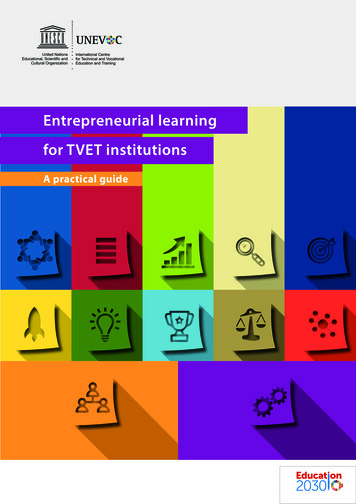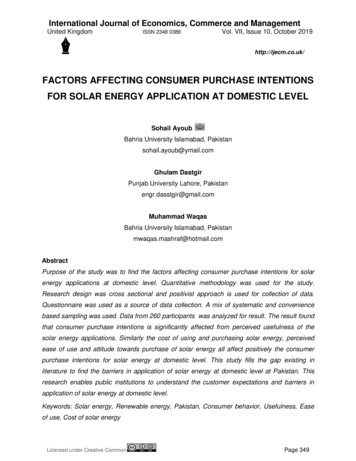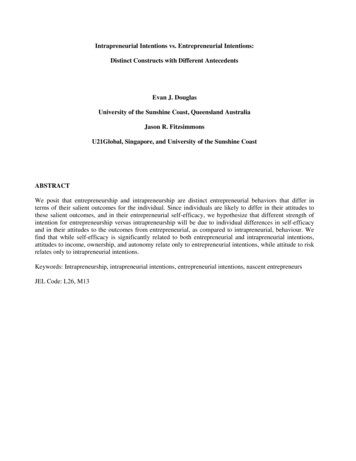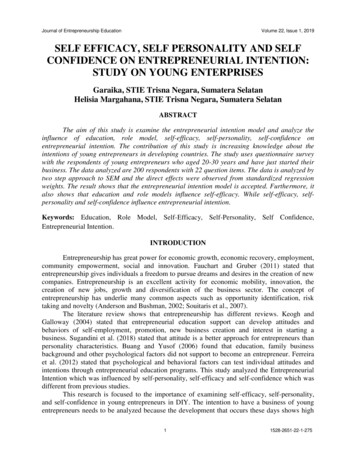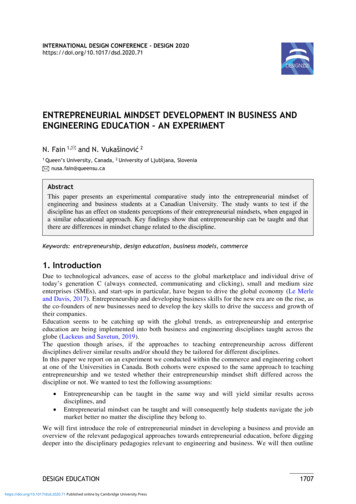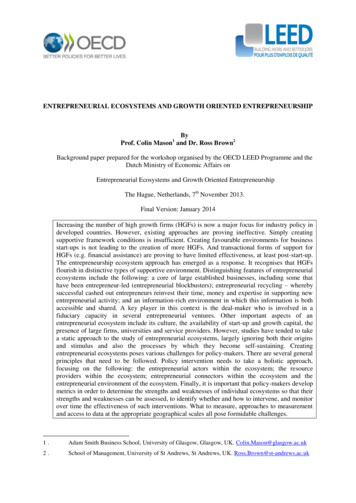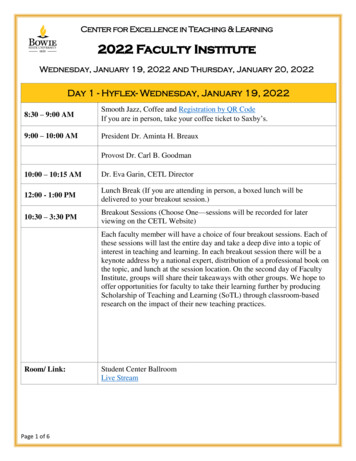
Transcription
Journal of Entrepreneurship EducationVolume 20, Issue 1, 2017FACTORS AFFECTING ENTREPRENEURIALINTENTIONS AND ENTREPRENEURIAL ATTITUDESIN HIGHER EDUCATIONViktoriia Potishuk, Berlin University of TechnologyJan Kratzer, Berlin University of TechnologyABSTRACTBased on the theory of planned behavior and opinion leadership, this study tests theeffect of opinion leaders, subjective norms, behavioral control, and course characteristics on theentrepreneurial attitudes and entrepreneurial intentions over the course of educationalprograms. Based on a longitudinal study during two summer schools offered from the EuropeanInstitute of Innovation and Technology (EIT) with 84 students, the following results were found.First, the education and environment at these summer schools affect entrepreneurial attitudes aswell as entrepreneurial intentions. Second, opinion leadership in entrepreneurship-related topicspositively influences changes in pro-entrepreneurial attitudes. Third, entrepreneurial attitudes,subjective norms, and behavioral control propel entrepreneurial intentions. The main theoreticalcontribution is the synthesis of formerly distinct research fields of planned behavior,entrepreneurship, and opinion leadership. The study also indicates readily applicable practicalsuggestions to improve entrepreneurship program that intent to improve entrepreneurialattitudes and norms.Keywords: Entrepreneurial attitudes, entrepreneurial intentions, opinion leaderINTRODUCTIONThere is no doubt about the fact that entrepreneurship is important for both the economyand for personal development (Fauziah et al., 2004). Indeed, entrepreneurial activity has a longlist of characteristics that serve the common good from the macro down to the micro-level.Entrepreneurship provides employment for many people while ensuring economic growth viataxes, ideas, and innovations. Entrepreneurship provides many opportunities for the developmentof knowledge and employee skills and motivates and rewards not only on a financial level, buton an individual level as well. According to Hisrich et al. (2005), entrepreneurship is a dynamicprocess of creating incremental wealth in which the wealth is created by individuals whoundertake the risks involved in terms of equity, time, and career. Entrepreneurship is a stepwiseprocess that is influenced by both exogenous and endogenous factors, such as the existence of abusiness-friendly environment, the availability of the required factor endowments, the ability toacquire desired resources, and the ability to implement and manage the business concept(Mueller, 2008; Morris et al., 2001).Numerous published studies have been devoted to the entrepreneur personality. Anentrepreneur is commonly characterized as an individual with a unique set of instincts, mindset,25
Journal of Entrepreneurship EducationVolume 20, Issue 1, 2017inspiration, or vision who has the strengths, willingness, and ability needed to conceptualizeideas and to implement a business plan and who sees change as an opportunity to create value(Cheng et al., 2009). For a long period of time, educators and professionals have been under thedelusion that entrepreneurs are born, not made. Later studies have claimed that entrepreneurshipcan be taught (Dickson et al., 2008; Gorman et al., 1997; Henry et al., 2005a, 2005b; Kirky,2004).Indeed, many studies have shown the interaction between entrepreneurship education andentrepreneurial intention (Baybashaija et al., 2011; Fayolle et al., 2005; Hassan and Wafa, 2012;Kolvereid and Moen, 1997; Noel, 2001; Paco et al. 2012; Peterman and Kennedy, 2003;Schlaegel and Koenig, 2014; Tkachev and Kolvereid, 1999; Upton et al., 1995; Webb et al.,1982; Zhang et al., 2014). A positive direct relationship between a university’s stimulatoryinvestment in entrepreneurship and the number of students becoming entrepreneurs has also beenfound (Varela and Jimenez, 2001). A large number of studies address and answer more detailedresearch questions: (1) Which course characteristics are more effective than others (Mueller,2008)? (2) Does prior experience matter (Ramayah et al., 2012)? (3) Which program-derivedbenefits raise entrepreneurial attitudes and intentions (Souitaris et al., 2007)? (4) What is theimpact of the educator profile on entrepreneurship education (Steiner, 2013)? However, so far,only a very limited number of studies have considered the personal characteristics of programparticipants and embedded role models as a possible influence on entrepreneurial attitudes andintentions.The goal of this study is to empirically test what factors stimulate entrepreneurialattitudes and entrepreneurial intentions during higher education programs using data collectedduring different summer schools offered by the European Institute of Innovation and Technology(EIT). These five-week-long summer schools were aimed toward raising entrepreneurial attitudeand entrepreneurial intention for masters and doctoral (PhD) students in the realm of climatechange mitigation and adaptation. In this longitudinal study, we investigated whetherentrepreneurial intention may be influenced by different kinds of opinion leaders, role models,course characteristics, entrepreneurial attitudes, subjective norms, and perceived behavioralcontrol. At the same time, we examined exactly what affects the entrepreneurial attitude of thestudents towards becoming an entrepreneur during these summer schools. The study has twomeasurement points at the beginning and at the end of the study including 84 students. The testsare examining the differences in attitudes and intentions at these to measurement pointsdepending on the mentioned independent variables.This study addresses the following research questions: (1) Is the entrepreneurial intentionof students positively influenced by entrepreneurial attitude, subjective norms, and perceivedbehavioral control? (2) What kind of course characteristics impacts the entrepreneurial attitude?(3) Do role models embedded in entrepreneurship courses impact the entrepreneurial attitude?(4) Do opinion leaders affect the entrepreneurial attitude? If yes, to what extent? By consideringthese questions, our study contributes to the existing literature in three ways. First, this studyattempts to synthesize the theory of planned behavior and opinion leadership. Second, this studyadds to prior research on entrepreneurship education by testing changes in entrepreneurialintentions and entrepreneurial attitudes caused by different factors over time. And third, this26
Journal of Entrepreneurship EducationVolume 20, Issue 1, 2017study is one of the first to consider the role of students as a determinant of success or failure tostimulate entrepreneurial intentions and entrepreneurial attitudes rather than external factors asteachers and environments.THEORETICAL BACKGROUND AND HYPOTHESESThe origins of entrepreneurship education are in the USA in the aftermath of World WarII. After Professor Myles Mace had come into contact with a number of members of the USArmy who hoped to start their own businesses, he proposed an educational course at HarvardUniversity that focused on how to start a small business. In 1947, the first course, “Managementof Small Enterprises”, was offered to returning World War II veterans. Currently, in mostdeveloped countries the biggest challenge for entrepreneurship is a comparatively low intentionand a high fear of starting a business.A common definition is applied internationally for characterizing “EntrepreneurshipDevelopment Programs” as “a collection of formalized teachings that informs, trains, andeducates anyone interested in participating in socio-economic development through a project topromote entrepreneurship awareness, business creation, and small business development, or totrain the trainers” (Berchard and Toulouse, 1998). There are different views regarding theclassification of entrepreneurship education (see Table 1). Depending on the objectives ofentrepreneurship education, there are different ways to provide the programs. As suggested byHytti and O’Gorman (2004), providing information through media campaigns and/or seminarsand lectures to students across all levels of the education system (primary, secondary, andhigher) and to the broader population effectively increases the awareness and understanding ofentrepreneurship. The objective of providing practical skills for entrepreneurial activity isfulfilled by providing information through education and training interventions. In the empiricalstudy by Souitaris et al. (2007), the entrepreneurship program is treated as a concept broader thana simple course, as long as it includes a portfolio of complementary activities. The authorssuggest that effective programs should consist of four components: (1) a “taught” component,with one or more modules;(2) a “business-planning” component, which can include business plan competitions andadvice on developing a specific business idea; (3) an “interaction with practice” component,which can include talks from practitioners and networking events; and (4) a “university support”component, which can include market research resources, space for meetings, a pool oftechnology with commercial potential, and even seed funding for teams of students.27
Journal of Entrepreneurship EducationVolume 20, Issue 1, 2017Table-1TYPES OF ENTREPRENEURSHIP PROGRAMS AND THEIR OBJECTIVESAuthorClassificationObjectivesEducation about enterpriseCreate awarenessDevelop practical skills for starting aEducation for enterpriseJamieson (1984)businessImprove skills for further enterpriseEducation in enterprisedevelopmentEducation about entrepreneurshipCreate theoretical knowledgeLaukkennen (2000)Develop and encourage entrepreneurialEducation for entrepreneurshipactivityBuild practical knowledge for selfEntrepreneurial educationemploymentEducation for small business ownership andFacilitate starting a business with a newCurran andself-employmentproduct/serviceStanworth (1989)Continuing small business educationBuild upon or update skillsSmall business awareness educationCreate awarenessTheory of Planned BehaviorThe theory of planned behavior (TPB) is an extension of the theory of reasoned action.Research performed in the behavioral sciences has proven that behavior can be predicted byintentions. According to the TPB, there are three conceptually independent predictors (attitudes)of intention, namely: attitude towards the behavior, subjective norms, and perceived behavioralcontrol. As stated by Ajzen (1991), a general rule of the theory is: “the more favorable theattitude and subjective norm with respect to a behavior, and the greater the perceived behavioralcontrol, the stronger should be an individual’s intention to perform the behavior underconsideration.” Notably, Ajzen expects the relative importance of attitude, subjective norm, andperceived behavioral control for the prediction of intention to vary across different behaviors andsituations.The nature of entrepreneurial activity is intention with entrepreneurship being a typicalexample of such planned, intentional behavior (Kim and Hunter, 1993;Krueger et al., 2000; Mueller, 2008; Souitaris et al., 2007).In the field of entrepreneurship, TPB was repeatedly tested by using self-employment asthe target behavior (Kolvereid, 1996; Krueger et al., 2000; Mueller, 2008; Souitaris et al., 2007).Descriptions of the main TPB constructs in psychology as well as entrepreneurship research areprovided in Table 2.28
Journal of Entrepreneurship EducationConstructIntentionAttitudetoward lVolume 20, Issue 1, 2017Table-2OVERVIEW OF THE MAIN TPB CONSTRUCTSPsychology researchEntrepreneurship research(Ajzen, 1991)(Kolvereid, 1996)State of mind directing a person's attention andTrying to perform a given behavioraction towards self-employment as opposed toorganizational employmentDegree to which a person has a favorableDifference between perceptions of personalor unfavorabledesirability in becoming self-employed andevaluation or appraisal of the behavior inorganizationally employedquestionPerceptions of what important people in respondents'Perceived social pressure to perform or not lives think about them becoming self-employed,to perform the behaviorweighted by the strength of the motivation to complywith these perceptionsPerceived ease or difficulty of performingthe behavior, which is assumed to reflectPerceived ability to become self-employedpast experience as well as anticipatedimpediments and obstaclesWhen applying the TPB conceptual model, we strived to find empirical proof thatintention is influenced by attitudes in order to assess whether the entrepreneurship program cancause changes in intentions. A relatively dated literature reviews by Gorman et al. (1997) claimsthat there is little empirical evidence for this. However, recent studies based on the TPB modelconfirm that there is an evident relationship between entrepreneurship education andentrepreneurial intention that is influenced by attitudes (Schlaegel and Koenig, 2014; Souitaris etal., 2007, Zhang et al., 2014), although the major studies argue that more evidence is still needed.Kolvereid (1996) calls for more studies based on other samples in order to back up the existingfindings. Krueger et al. (2000) did not succeed in establishing a relation between intention andsubjective norms, and Souitaris et al. (2007) failed to find any effects of educational programs onthe change in attitude towards self-employment and perceived behavioral control. In general,there are some criticism on TPB as summarized in Hardeman et al. (2002) and Sniehotta et al.(2014). Consequently, in order to reaffirm the TPB conceptual model and confirm the influenceof entrepreneurship education on intention, we pose the following hypotheses:Hypothesis 1Pro-entrepreneurial attitudes of individuals positively influence their entrepreneurialintentions.Hypothesis 2Individuals with pro-entrepreneurial subjective norms show an increased level ofentrepreneurial intention.Hypothesis 3Pro-entrepreneurial perceived behavioral controls of individuals positively influencetheir entrepreneurial intentions.Hypothesis 4Participation in the entrepreneurship course positively affects entrepreneurial intentionsof individuals and consequently pro-entrepreneurial attitudes, subjective norms, andperceived behavioral controls as well.29
Journal of Entrepreneurship EducationVolume 20, Issue 1, 2017Course characteristicsAccording to the conversational framework of Laurillard (2002), the essence ofuniversity teaching is an iterative dialogue between the teacher and the student(s). The entireframework operates on two levels: (1) the discursive, theoretical, and conceptual level and (2)the active, practical, and experiential level. The two levels are bridged when students engage inthe processes of adaptation (practice in relation to theory) and reflection (theory in the light ofpractice). Correspondingly, student-oriented courses include the following aspects: (1) discursiveelements, such as the sharing of concepts between teachers and students; (2) adaptive elements,which imply that students have the chance to receive feedback and are responsible forconsidering this feedback in their further studies; (3) interactive elements, which includemeaningful intrinsic feedback provided by teachers; and (4) reflective elements, which providestudents with the chance to reflect on task goals, act accordingly, receive feedback and relate thefeedback to their conception of the topic. The effectiveness of the student-oriented approach wasconfirmed in an exploratory study by Mueller (2008). The interviewees confirmed theimportance of each listed element above by mentioning that discussion and active participationbenefitted the aims of entrepreneurship courses. The contrast of student-orientation would beteacher-centered courses with a low level of student involvement. Therefore, we propose thefollowing:Hypothesis 5Student-oriented courses positively influence pro-entrepreneurial attitudes of theparticipants.Role ModelsAccording to previous research (Bandura, 1997; Carsrud et al., 1987), role models tend tobe the basis for increasing entrepreneurial intention. Contact with professionals lends inspirationto the learning process; moreover, one may adopt the role model’s attitude if one associateshis/her own personality with that of the role model (Elmore, 1991; Krueger et al., 2000; Scottand Twomey, 1988). The exploratory study by Mueller (2008) based on interviews conductedamong lecturer’s shows that inviting guest speakers (entrepreneurs) is an important feature ofentrepreneurial courses. Furthermore, the motivational effect is higher if course participants canidentify with the speakers, i.e. if students think to themselves: “If they could do it, I can do it aswell”. As the same time, the quantitative study by Mueller (2008) proves that courses thatprovide the opportunity to contact role models with whom students can identify positivelyinfluence the entrepreneurial attitude towards founding one’s own company. We aim to replicatethese results using our data sample and suggest the following:Hypothesis 6The integration of role models into the entrepreneurship program positively influences thepro-entrepreneurial attitude of individuals.30
Journal of Entrepreneurship EducationVolume 20, Issue 1, 2017Opinion LeadershipThe academic study by Martens (1998) illustrates an example of an American nonsmoking campaign among young individuals. After having learned that a traditional campaignutilizing brochures results in high expenditures without reasonably successful results, a differentapproach was used. Opinion leaders within the class were targeted in order to convince theclassmates of the hazards of smoking. Ultimately, the second approach was more effective. Aspreviously explained, leadership is based on relationships, is meant to create change, and can beassumed by anyone (Zekan et al., 2012). Several studies in clinical practice and consumerbehavior have defined opinion leaders as individuals who, to an extent, influence the opinions,attitudes, beliefs, knowledge, and behaviors of others, and who have demonstrated effectivenessin disseminating information about new ideas and techniques (Potishuk and Kratzer, 2012).Moreover, opinion leaders have special qualities, knowledge, and skills. Previous findings claimthat opinion leadership is a two-way interaction and not a generalized trait (Myers andRobertson, 1972). In other words, opinion leaders send and receive information, can influenceothers, and can be influenced by others. In the case of study programs opinion leaders mightappear among class mates. This is a usual case in larger school groups that are determined byopinion leaders (Kratzer and Lettl, 2009).Hypothesis 7Individuals with opinion leader characteristics can influence the attitudes of others.Hypothesis 8Individuals who are opinion leaders in entrepreneurship-related topics positivelyinfluence changes in pro-entrepreneurial attitudes of other program participants.METHODOLOGYSampleOur sample of 84 students is based on questionnaires completed by participants at thebeginning and end of two “The Journey” summer schools initiated in 2012 by the EIT ClimateKIC (Knowledge and Innovation Community). The program “The Journey” is a new and uniqueinitiative of the EIT that is financed by the European Commission aimed to stimulate solutiondriven behavior to issues around climate change mitigation and adaptation. Climate-KIC itself isa public-private community initiated and financed by the EIT that focuses on innovation in thearea of climate change. One of its key activities is education. “The Journey” aims to fosterentrepreneurial thinking by (1) increasing awareness for business opportunities related to climatechange, (2) providing the skills and tools to translate business ideas into business solutions toclimate change and (3) creating climate change-relevant start-ups. “The Journey” is a five-weekintensive climate change innovation and entrepreneurship summer course based in threeEuropean locations.31
Journal of Entrepreneurship EducationVolume 20, Issue 1, 2017Data CollectionIn order to collect the necessary information, the following research method wasdeveloped and applied. The participants were asked to fill in ex-ante and ex-post questionnaireswhen entering and exiting the program, respectively. The data gathering took place during thecourse and one researcher was always present to distribute and collect the completed forms aswell as answering possible questions. Such measures as entrepreneurial intention, entrepreneurialattitude, subjective norms, and perceived behavioral control were measured twice, while theinformation about the course characteristics and opinion leadership was measured only once,either at the beginning or at the end of the program. The measures are self-reported measure.Heneman (1974) found that self-report measures had less restriction of range and leniency thanpurportedly more objective supervisor ratings. Since the summer school was executed withchanging staff and the students were accompanied only by coaches throughout, we decided torely on self-reports rather than on supervisor ratings.MeasuresAttitude towards Being an Entrepreneur:Developed items are based on the measure proposed by Kolvereid (1996) and reflect thereasons for being an entrepreneur or an organizational employee. The following employmentchoices were considered in the survey questions: (1) being an entrepreneur: economicopportunity (one item), challenge (two items), autonomy (two items), authority (two items), selfrealization (one item), participation in the entire process (one item); (2) being employed inorganization: security (one item), work load (one item), social environment (one item), avoidingresponsibility (one item), and career (one item). Moreover, following Ajzen’s (1991) researchmethod, we included three items aimed to evaluate certain behaviors from the perspective ofvalue (doing so is valuable/not valuable) and pleasure (doing so is pleasant/unpleasant). Afterrunning the reliability test, one item was excluded. In total, 16 items comprise the scale ofattitude with Cronbach’s Alpha values of 0.751 and 0.797 for the ex-ante and ex-postquestionnaires, respectively. The scale is calculated by extracting the average mean of all itemscores.Subjective Norms:As a developmental construct for the subjective norms, we have used Ajzen’s (1991)suggestions concerning this issue. Direct questions should be asked about the subjective normsof participants. While developing the items for scale, we took into account several importantmeasures such as direct measures (two items), descriptive norms (one item) and motivation tocomply (two items). We calculated the scale by summing up the results of the followingmultiplications: the perceived expectations of the family/others and the motivation to complywith these expectations, as well as the actual behavior of important individuals and themotivation to comply with these people. Finally, the scale reliability was tested using direct32
Journal of Entrepreneurship EducationVolume 20, Issue 1, 2017measures and descriptive norms. Consequently, Cronbach’s Alpha value is estimated at the levelof 0.765 (ex-ante questionnaires) and 0.746 (ex-post questionnaires).Perceived Behavioral Control:According to Ajzen (1991), perceived behavioral control reflects the confidence ofindividuals in their capability to perform the target behavior. A number of different items shouldreflect the respondent’s perceived capability and controllability of performing the behavior. Theaverage sum of seven items comprises the scale with Cronbach’s Alpha at 0.761 (ex-ante) and0.800 (ex-post).Entrepreneurial Intention:As with the previously developed scales, we followed Ajzen’s recommendations whenconstructing the TPB questionnaire. In order to measure intention, the use of statements withdirect meanings is recommended. The answers should indicate the degree of readiness andwillingness to perform the target behavior. Finally, a set of three items make up the scale ofentrepreneurial intention with reliability values of 0.858 (ex-ante) and 0.819 (ex-postquestionnaire). The scale was calculated by averaging the sum of the item scores.Student Orientation:A five-point-scale of student orientation was developed based on previous studies. Thisscale measures extent to which the entrepreneurship program is teacher or student-centered. Thefinal scale is the mean value of the indices developed by Laurillard (2002) and replicated byMueller (2008) – namely, discursive (3 items), adaptive (2 items), interactive (8 items), andreflective (3 items) elements. Sixteen questions were posed to the respondents (see Table 3). Thereliability test provided a Cronbach’s Alpha value of veTable-3ELEMENTS OF STUDENT-ORIENTED TEACHING PROCESSThe purpose of the questionsReflects the availability of discussions in the class and the influence of students on theobjectives and topicsReflects the availability of discussions in the class and the adaptability of the objectives andtopics according to the student’s knowledgeReflects the availability of feedback, encouragement, and support within the classReflects the availability of emphasis on the advantages and disadvantages of entrepreneurship,and gives consideration to starting the businessRole Models:Because contact with professionals and family inspires the learning process, the rolemodel scale was developed for measuring the influential effect of guest speakers andentrepreneurs in the class. The students had to indicate to what kind of role models they had33
Journal of Entrepreneurship EducationVolume 20, Issue 1, 2017personal contact. The summarized item scores of four questions form the scale. The Cronbach’sAlpha value of the variable was 0.796.Opinion Leaders:To measure opinion leadership, the self-reposting technique was selected for thefollowing reasons: the method does not require involvement of additional respondents; it is asuitable solution for quantitative studies; and it is the only feasible technique for delimited anduniform social networks that can be usefully applied to networks of professionals andcommunities with mutual interests (Potishuk and Kratzer, 2012). For measuring opinionleadership among participants, we adopted the scale of Flynn et al. (1996). The scale contains 6items: importance of the opinion (1 item), authority of the person (2 items), frequency ofinformation given (1 item), and ability to persuade (2 items). Before calculating the scale, wealigned all items with the same direction. Consequently, the lower the total score, then thegreater the opinions of the leadership characteristics. The final scale was calculated by averagingthe sum of all item scores. The reliability test indicated Cronbach’s Alpha to be 0.762 for opinionleadership in climate science and 0.708 for opinion leadership in entrepreneurship.Analytical TechniquesAccording to the developed research design, we tested the TPB model at the beginningand the end of the program. Therefore, we could only analyze matched questionnaires (ex-anteand ex-post). 138 questionnaires were completed by the students. All results are presented inTables 4–8. The means, standard deviations, and bivariate correlations of the sample data arepresented in Table 4. The overall correlation shows that all variables could be included in theregression model; none of the variables are highly correlated with each other. We also performedthe collinearity diagnostics on all variables as part of the multiple regression procedure. Thishelped us to verify the problem of multicollinearity, which may not be evident in the correlationmatrix, by analyzing the tolerance and variance inflation factor (VIF). Both indicators havevalues that do not violate the multiple regressions (tolerance 0.10 and VIF % 10). All resultsdesignated as statistically significant refer to α of 0.10 (1-tailed) and 0.05 (2-tailed) or lower.RESULTSWe used the correlation matrix in order to check the validity of the developed conceptualframework (see Table 4). Every suggested relationship was confirmed. A positive relationshipbetween entrepreneurial intention and attitude, subjective norms, and perceived behavioralcontrol was observed. In order to determine the strength of this correlation, we used theguidelines of Cohen (1988), who suggests the following classification system: small (r 0.10–0.29), medium (r 0.30–0.49), and large (r 0.50–1.0). Therefore, we conclude that at Time 1(ex-ante), the attitude and subjective norms have a medium relationship with entrepreneurialintention (r 0.370 and r 0.437, respectively), while perceived behavioral control has a largerelationship (r 0.574) with entrepreneurial intention. Meanwhile, at Time 2 (ex-post), theattitude and perceived behavioral control have a strong relationship (r 0.506 and r 0.503,34
Journal of Entrepreneurship EducationVolume 20, Issue 1, 2017respectively), while subjective norms have a small relationship (r 0.297) with entrepreneurialintention. Moreover, there is medium positive relationship between difference in attitude andstudent orientation (r 0.442), role models (r 0.415) and opinion leadership inentrepreneurship (r 0.257).Hierarchical multiple regression was used to assess the ability of three control measures(attitude, subjective norms, and perceived behavioral control) to predict levels of entrepreneurialintention at two different points in time after controlling for the influence of age and gender (seeTable 5). Age and gender were entered at Step 1, explaining 4.1 % of the variance inentrepreneurial intention. After the entry of attitude at Step 2, the total variance explain
measurement points at the beginning and at the end of the study including 84 students. The tests are examining the differences in attitudes and intentions at these to measurement points depending on the mentioned independent variables. This study addresses the following research questions: (1) Is the entrepreneurial intention
